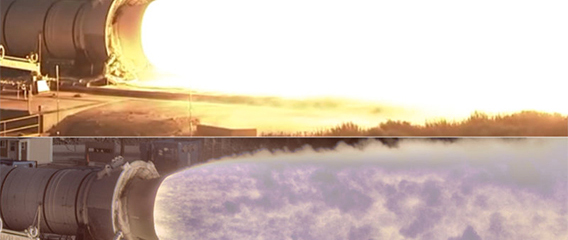Nasa’s New High Dynamic Camera Records Rocket Test
While thousands turned out watch NASA’s Space Launch System (SLS) recently complete a full-scale test of its booster, few were aware of the other major test occurring simultaneously.
NASA’s High Dynamic Range Stereo X (HiDyRS-X) project, a revolutionary high-speed, high dynamic range camera, filmed the test, recording propulsion video data in never before seen detail.
The HiDyRS-X project originated from a problem that exists when trying to film rocket motor tests. Rocket motor plumes, in addition to being extremely loud, are also extremely bright, making them difficult to record without drastically cutting down the exposure settings on the camera.
Doing so, however, darkens the rest of the image, obscuring other important components on the motor.
Traditionally, video cameras record using one exposure at a time, but HiDyRS-X records multiple, slow motion video exposures at once, combining them into a high dynamic range video that perfectly exposes all areas of the video image.
 Image of Space Launch System Qualification Motor 2 test or, QM-2, without using HiDyRS-X camera
Image of Space Launch System Qualification Motor 2 test or, QM-2, without using HiDyRS-X camera
 Image of Space Launch System Qualification Motor 2 test or, QM-2, with HiDyRS-X camera.
Image of Space Launch System Qualification Motor 2 test or, QM-2, with HiDyRS-X camera.
The HiDyRS-X project began as part of NASA Space Technology Mission Directorate’s Early Career Initiative (ECI), designed to give young engineers the opportunity to lead projects and develop hardware alongside leading innovators in industry. Howard Conyers, a structural dynamist at NASA’s Stennis Space Center, was awarded as an ECI grant in 2015. After initial proof of concept and a preliminary design review, the HiDyRS-X project was placed within NASA’s Game Changing Development program to complete its first prototype. Created in partnership with Innovative Imaging and Research Corporation, the project was tested on small rocket nozzle plumes at Stennis.
The massive booster test served as a rare opportunity to test the HiDyRS-X hardware in a full-scale environment. The Qualification Motor 2, or QM-2, test was held at Orbital ATK’s test facility in Promontory, Utah, and was the second and final booster test before SLS’s first test flight in late 2018. SLS will be the most powerful rocket in the world, and will take our astronauts farther into deep space than ever before.
[NASA]
© 2016 Copyright ShootTheCenterfold.com. All rights reserved.























